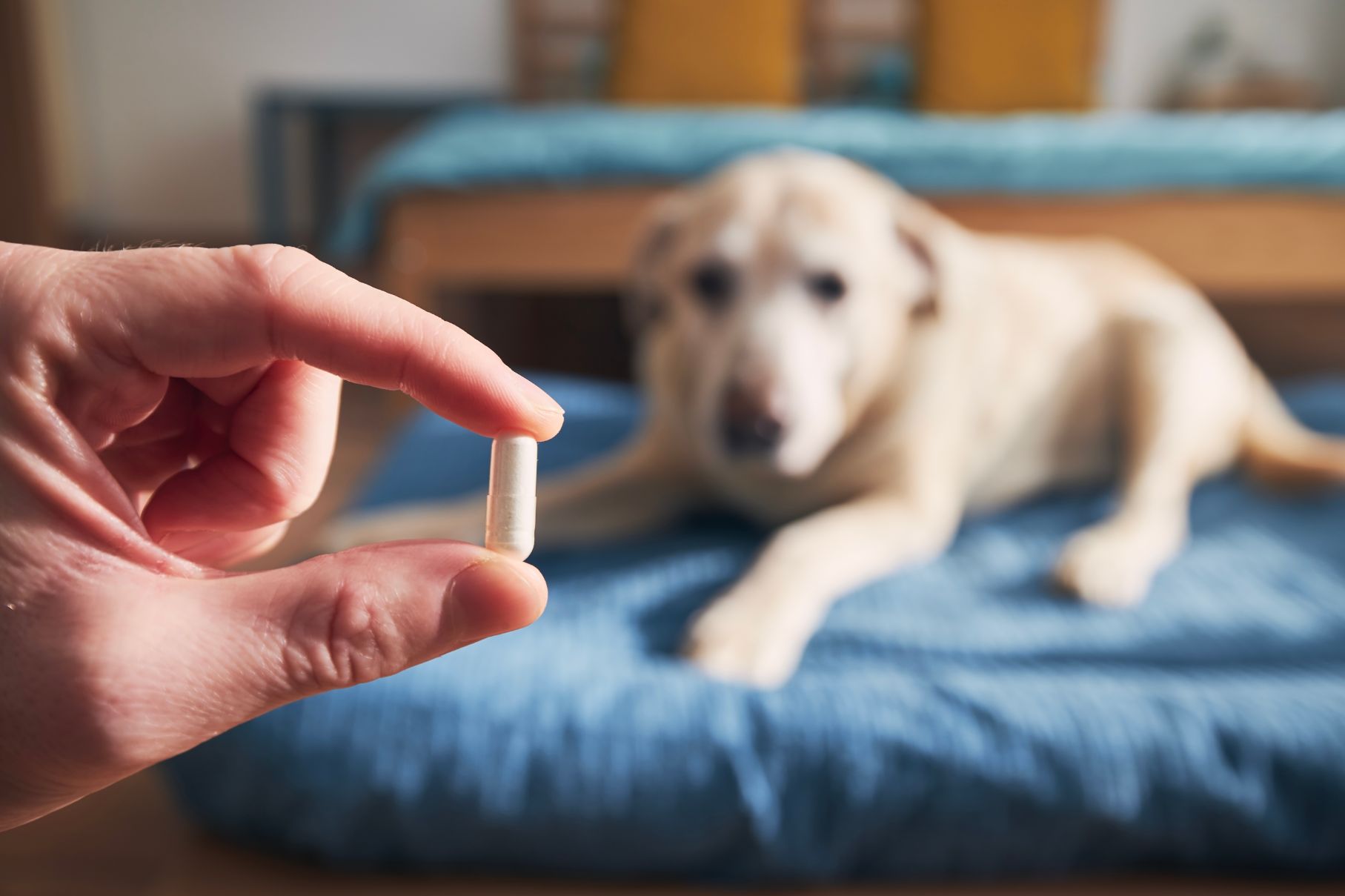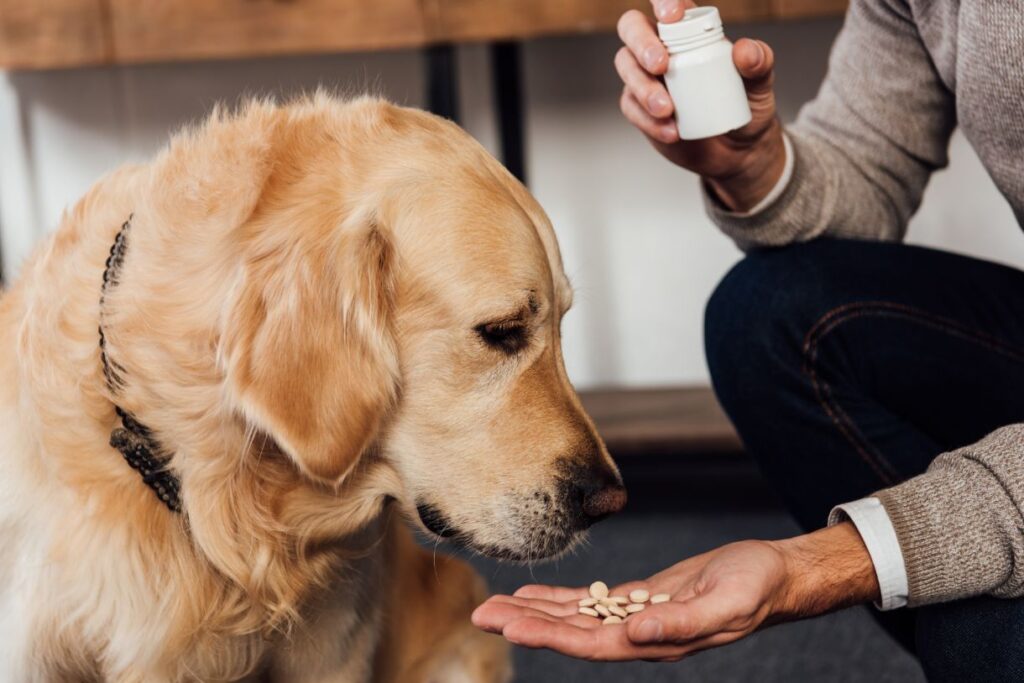Table of Contents
Humans and dogs have a near-similar circadian rhythm. Also known as the circadian cycle, the circadian rhythm refers to a natural, internal mechanism in animals that regulate the sleep-wake cycle, typically over a 24-hour period.
Just like humans, a dog’s sleep-wake cycle follows a particular sequence whereby the animal sleeps during the night and remains active throughout the day. However, these rhythms can suffer massive disruptions occasioned by conditions like sleep disorders, chronic pain, and anxiety issues.
Since melatonin supplements are usually prescribed for humans suffering from sleep deprivation, it’s natural to think that our canine friends can also benefit from these products. But can dogs have melatonin?
The answer is a resounding yes. While research on the efficacy of melatonin in dogs is still work in progress, the little information already out there is quite promising. Available evidence indicates that melatonin may help dogs battling insomnia and many other sleep disorders, including sleep apnea and restless leg syndrome.
This post delves deeper into the possible effects of melatonin in dogs and how to make the most of these supplements.
More About Melatonin
Melatonin is a naturally-occurring compound secreted by plants and animals. The compound is primarily known in animals as a sleep-aiding hormone. It’s released by the brain’s pineal glands.
Melatonin secretion peaks in the evening, where it signals the body that it’s time to go to sleep. Increased melatonin levels in the body promotes quality sleep by shortening sleep latency (the average duration it takes to drift from a complete state of wakefulness to sound sleep).
As a sleep-aiding hormone, melatonin is also noted for its sedative effects. The hormone calms the mind of racing thoughts while clearing butterflies from the stomach. The end result is a relaxed state of mind and body.
Not only does melatonin help you sleep well at night. The hormone can also regulate your circadian rhythms. That’s due to the alternating fluctuations in melatonin levels in the body. Melatonin secretion peaks in the evening but then begins to drop once you’re sound asleep. The amount of melatonin in your bloodstream is usually at the lowest around dawn. That’s how you know it’s time to wake up and face the day.
Besides the natural melatonin secreted by the brain’s pineal glands, we also have synthetic melatonin supplements sold over the counter. These supplements are typically available as chewable pills and tablets, oral tinctures intended for sublingual administration, or herbal teas. The products are usually the first port of call when looking for sleep medications.
Uses of Melatonin in Dogs
There are several medical conditions in dogs that you can treat or manage using melatonin supplements. Common ones include;
1. Insomnia
Insomnia is defined as the inability to fall asleep or stay asleep for large blocks of hours. The condition typically occurs alone. But it can also be a symptom of an underlying disease, particularly cognitive dysfunctions that disrupt your dog’s natural biorhythms.
Common symptoms of insomnia include lethargy, daytime grogginess, and irritability.
Whatever the cause, administering melatonin can go a long way in helping your pooch get a good night’s sleep.
2. Anxiety Disorders
Insomnia and anxiety often share a cause-effect relationship.
Sadly, dogs can suffer from various anxiety disorders that could trigger insomnia or worsen their preexisting sleep problems. Common ones include post-traumatic stress disorder (PTSD) and separation anxiety.
In addition to full-blown anxiety disorders, your dog might also experience situational anxiety caused by environmental factors like fireworks in the neighborhood or thunderstorms. These occasional stressful moments might also interfere with your dog’s sleep-wake cycles, necessitating melatonin supplementation.
3. Cushing’s Disease
Cushing’s disease is marked by the over-secretion of the hormone cortisol. Your dog’s body requires normal cortisol levels to regulate stress responses and other immune functions. The hormone is particularly important during fight-flight moments.
However, too much cortisol levels can throw your dog’s circadian rhythms off balance. Besides, the hormone is associated with muscle weakness, fatigue, frequent urination, and skin conditions.
Studies have established that melatonin might help to treat Cushing’s disease resulting from tumors on the pituitary or adrenal glands.
4. Alopecia
Some dogs experience seasonal flank alopecia during the winter months, whereby they lose hair patches on their lower backside.
The condition usually occurs alone and is typically not accompanied by any other skin disorders.
According to some veterinary officers, melatonin may help to treat seasonal flank alopecia in dogs. That’s due to the hormone’s ability to promote hair regrowth.
Ways to Administer Melatonin to Dogs
There are four primary ways to administer melatonin to dogs. They include;
a) Pills and Tablets
Melatonin supplements are commonly available as tablets or capsules. You simply hide the pills inside a solid mass of food and then administer the drugs to your dog alongside the food.
b) Tinctures
Melatonin may also be available as oral tinctures. Tinctures are basically liquid forms of a drug, which usually contain the medication suspended in a suitable alcohol solution. To administer oral tinctures, drip a few drops of the liquid underneath your dog’s tongue.
c) Chewables
Chewable melatonin supplements look and taste like regular pet treats, which makes them remarkably easy to administer. These products are especially suitable for skittish dogs who may express aversions to oral tinctures.
d) Implants
In rare cases, melatonin may be administered as an implant. This process basically involves the surgical insertion of a melatonin-releasing device under your dog’s skin.
How Much Melatonin Can Dogs Have?
Like any supplement, melatonin is safe and effective for dogs only if administered in the right doses.
Note that there’s no standard rule for the exact amount of melatonin to give to your pooch. The quantity depends on factors like the animal’s age, breed, and overall medical condition.
However, the following guide may come in handy if unsure of the right amount of melatonin to give to your pooch;
• Dogs less than 10 pounds (lbs) – 1 mg, three times a day
• Dogs weighing between 10 and 25 lbs – 1.5 mg, three times a day
• Dogs weighing between 26 and 100 lbs – 3 mg, three times a day
• Dogs weighing over 100 lbs – 2 – 6 mg, three times a day
Can Dogs Overdose On Melatonin?
Melatonin overdose in dogs is uncommon. But that doesn’t mean it cannot occur. Cases of overdose are common when instructions are totally ignored.
In addition to being counterproductive at high doses, giving your dog too much melatonin could leave him with a slew of side effects.
Some of the negative effects of melatonin overdose in dogs include;
• Upset stomach
• Prolonged lethargy
• Elevated heart rate
• Irritability
• Itching
• Confusion
• Changes in the female reproductive cycle
Final Word
Dogs can benefit from melatonin the same way humans can. However, care should be taken when administering this hormonal supplement to your dog.
The conventional wisdom is to consult your veterinarian before giving your pooch melatonin. And as a best practice, avoid administering melatonin to your dog alongside other sleep medications.





